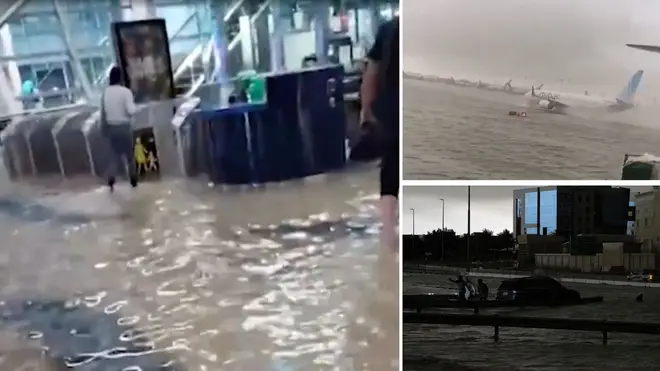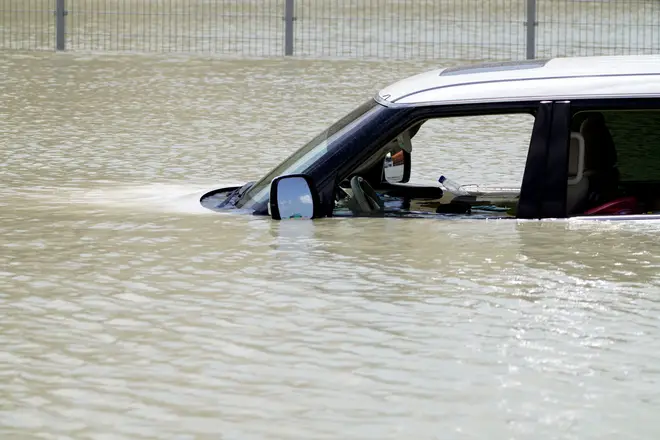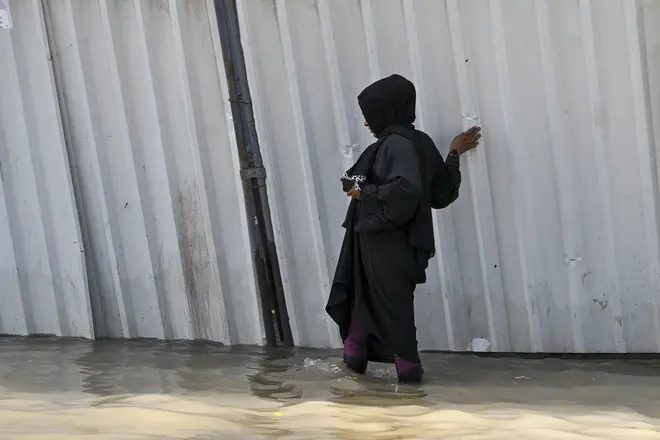
Clive Bull 1am - 4am
17 April 2024, 14:18 | Updated: 17 April 2024, 14:43

Apocalyptic flooding in Dubai which has left thousands stranded may have been induced by cloud seeding operations, analysis shows.
Cloud seeding is a strategy used to induce rainfall by firing salt flares into clouds to speed up condensation and is a method used in the UAE to solve water shortages.
Seeding operations were first introduced in the desert nation in 2002, and the country now reportedly carries out over 1,000 hours of seeding operations annually.
However, after the country was hit by the heaviest rainfall ever recorded on Tuesday and continues to suffer in the aftermath today, some have suggested the flooding may have been a result of the man-made method.
The apocalyptic scenes on Tuesday saw planes swimming in floodwater and shopping malls being swamped.
Footage showed luxury cars submerged in deep water and waves buffeting the traffic while high-end muscle cars and Teslas struggled through the floods.
Flight-tracking data has since shown that an aircraft vehicle affiliated with the UAE’s cloud seeding team flew around the country on Sunday, according to analysis by the Associated Press.
Read more: Families rush to flee Dubai amid flood chaos as luxury cars swamped and residents jet ski down roads

Meanwhile, Ahmed Habib, a meteorologist at the UAE’s National Centre of Meteorology (NCM), also told Bloomberg that multiple cloud seeding flights were carried out in the days before the intense flooding.
Cloud seeding is a controversial method due to concerns about its environmental impact, efficacy and general ethical implications.
Some critics have flagged concerns about firing foreign substances into the atmosphere, suggesting it may affect air quality and ecosystems.
Despite speculation that the horrific weather may have been induced by cloud seeding, the NCM has since denied that these operations had taken place.
The NCM said that while the strategy had been used on Sunday and Monday, it had not been employed on the day of the unprecedented rainfall.
Omar AlYazeedi, deputy director general of the NCM, said the institution “did not conduct any seeding operations during this event”.
He told CNBC: “One of the basic principles of cloud seeding is that you have to target clouds in its early stage before it rains, if you have a severe thunderstorm situation then it is too late to conduct any seeding operation.”
The NCM instead attributed the storm to natural rainfall.
Mr AlYazeedi added: “We take the safety of our people, pilots, and aircrafts very seriously. The NCM does not conduct cloud seeding operations during extreme weather events.”

Dubai hit by mass flooding after year's worth of rainfall in a day

After his previous comments, Mr Habib later clarified that while six pilots had flown as part of routine protocol, they did not seed any clouds.
City authorities advised people to stay home after more than 4.7ins of rain fell on Tuesday - the typical yearly average in the city.
Video footage from inside Dubai’s airport showed passengers sleeping on the floor as they waited for flights to leave the waterlogged country.
Dubai airport's official Twitter posted on Wednesday morning: "We advise you NOT to come to the airport, unless absolutely necessary. Flights continue to be delayed and diverted. Please check your flight status directly with your airline. We are working hard to recover operations as quickly as possible in very challenging conditions."
In another video that surfaced on social media a man was seen jet skiing down a flooded street.
Nearly 50 flights in and out of Dubai were cancelled as a result, with aircrafts seen cutting through water at Dubai International Airport - the world's busiest for international travel.
my rolls royce got flooded and we’re stuck in the middle of the road in dubai 🙃 pic.twitter.com/3A9BPjusua
— Jordan Welch (@jrdnwelch) April 16, 2024
The airport later announced that all arriving flights would be diverted until the end of the day.
Shopping malls were left swamped too, with visitors seen wading through water at the Dubai Mall and Mall of the Emirates.
The city's skies turned dark mid-afternoon as the weather worsened. Lightning could be seen flashing across the sky, occasionally touching the tip of the Burj Khalifa, the world's tallest building.
Schools across the UAE were largely shut ahead of the storm and government employees worked remotely.
But locals still weren't safe as patio furniture flew through the streets due to the strong winds.
Meanwhile, authorities sent tanker trucks out into the streets to pump away the water.
Unstable weather conditions are expected to continue in the region through to Wednesday, UAE's National Centre of Meteorology said.
Rain is unusual in the UAE, but occurs periodically during the cooler winter months. Many roads and other areas lack drainage given the lack of regular rainfall, causing flooding.
Rain also fell in Bahrain, Qatar and Saudi Arabia.
No overall damage or injury information has been provided by the hereditary rulers of the nation as of yet.
However, police in Ras al-Khaimah reported that one 70-year-old man died after his vehicles was swept away in floodwater.